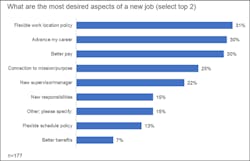Delta Variant Has Workers Worrying About Returning to Office
“With headlines about the rise of the Delta variant, breakthrough cases among the vaccinated, and an overburdened healthcare system in much of the country, COVID-19 concerns that were subsiding just two months ago have risen,” said Rebecca Ray, executive vice president of Human Capital at The Conference Board.
Conducted in August by The Conference Board, the new survey captured the thoughts of more than 2,400 U.S. workers on topics including return-to-work anxiety, factors driving them to pursue new job opportunities, opinions about remote work, and more.
The survey findings also reveal that more than one-third of workers may leave their jobs within the next six months. The driving factor: a desire for flexible work arrangements. Indeed, 80% cite work arrangements as very important or important in their decision to leave their current job. Survey respondents rank a flexible work location as the most desired aspect of a new job, prioritizing it slightly over better pay and career advancement, the two traditional drivers of job changes.
Key findings from the nationwide survey include:
- When it comes to returning to the workplace, women are more concerned than men about COVID exposure, job security, and mental health:
Contracting COVID-19 personally:
--Women: 48%
--Men: 37%
Exposing family members:
--Women: 46%
--Men: 40%
Pressure to return to the workplace to keep their jobs:
--Women: 25%
--Men: 15%
Deterioration of mental health:
--Women: 27%
-- Men: 11%
- Millennials are also more concerned than other generations about COVID exposure, job security, and mental health:
Contracting COVID-19 personally:
-- Millennial: 53%
-- Gen X: 41%
-- Baby Boomer: 45%
Exposing family members:
-- Millennial: 61%
-- Gen X: 42%
-- Baby Boomer: 40%
Pressure to return to the workplace to keep their jobs:
-- Millennial: 30%
-- Gen X: 21%
-- Baby Boomer: 19%
Deterioration of mental health:
-- Millennial: 38%
-- Gen X: 21%
-- Baby Boomer: 16%
Workers, especially women and Millennials, continue to question the wisdom of returning to the workplace given the belief that productivity remained high while working remotely.
--Women: 42%
--Men: 28%
--Millennial: 48%
--Gen X: 38 %
--Baby Boomer: 33%
Making moves: More than one-third may leave their organizations within the next six months.
- 29% of respondents are unsure if they will remain at their current job for the next six months.
- Only 7% are sure of their plans to leave within that time frame.
- 63% indicate they are not planning to leave in the next six months.
- More men than women are more certain that they will remain with their organizations for at least the next six months: Women: 59% Men: 70%
- More women than men, on the other hand, are not sure of their plans: Women: 33%, Men 23%
The top reason workers are looking for new jobs: inflexible work arrangements.
- More than 80% cited the importance, at some level, of work arrangements such as flexible hours and work location in their decision to find a new job.
-- Very important 60%
--Moderately important: 20%
--Slightly important: 9%
- Work arrangements were very important to more women than men:
--Women: 66%
--Men: 49%
- Work arrangements were very important to more Millennials than other generations:
--Millennial: 67%
--Gen X: 58%
--Baby Boomer: 59%
What are workers looking for the most? A flexible work location.
For those respondents planning to leave their organizations within the next six months, flexible work location topped better pay and career advancement—albeit slightly—as the most desired aspect of a new job.
“The long-term effect of extended remote working arrangements has left its mark. Employees are much less willing to embrace the rigid, conventional work policies of the past about how and where work gets done,” said Ray. “Especially for women, to whom the bulk of caretaking and household responsibilities still, unfortunately, fall, the flexibility to choose what works best for them is critically important. We are starting to see companies with flexible work arrangements successfully attracting the top talent of their competitors who have adopted a more rigid stance. The challenge of attracting and retaining talent in a tightening labor market is only going to become more difficult.”
Is going to the office full-time a thing of the past? Most workers want hybrid work arrangements.
- More than two-thirds (67%) of survey respondents are willing to work a hybrid work schedule (some days remotely, some days in the workplace).
- 20% of surveyed workers only want to work remotely.
- Only 4% say they want to work entirely in the workplace.
- Lower-level employees are more likely than higher-level employees to only want to work remotely:--Individual contributors: 32%, CEOs: 5%
- More women than men only want to work remotely:-Women: 23%,Men: 14%
- More Millennials than other generations only want to work remotely:
--Millennial: 25%
--Gen X: 19%
--Baby Boomer: 20%
The push for remote work may come at a cost: less connectedness, blurred boundaries, career stagnation.
- 58% of respondents said their greatest concern about working remotely was lack of connection with colleagues.
- Other top concerns about remote work include lack of boundaries around work/life, working more hours, lack of visibility/exposure that may impede upward mobility, and increased isolation.
- Men are more concerned than women about lack of connection with colleagues:
--Women: 57%
--Men: 69%
- Concern about lack of connection with colleagues was also greatest among Millennials:
--Millennial: 65%
--Gen X: 60%
--Baby Boomer: 61%
- This concern also increases by seniority level:-Individual contributors: 58%,CEOs: 70%
- Women are also more concerned than men about a lack of boundaries around work/life and working more hours:
--Boundaries: Women: 48%, Men: 44%
--More hours: Women: 48% Men: 41%
“A desire to work remotely doesn’t mitigate legitimate concerns about the downsides of remote work,” said Robin Erickson, Ph.D., Principal Researcher, Human Capital at The Conference Board. “For example, those who are more likely to want to work remotely—women, millennials, and individual contributors—are also most concerned with a lack of connection with colleagues when doing so. As organizations make long-term decisions about a future with remote work, they will need to bear this in mind and continuously monitor employee experience and well-being.”
Engagement levels are losing ground.
- Compared to pre-pandemic levels, 7% fewer respondents reported that their engagement level had increased compared to respondents to the same question just two months ago. In June, 37% of respondents said that their level of engagement had increased; in August, that number dropped to 30%.
- Workers who indicated that their engagement had decreased rose slightly from 15% in June 2021 to 19% in August.
- Roughly half of the respondents indicated that their engagement now had remained the same when compared to pre-pandemic levels.
About the Author
EHS Today Staff
EHS Today's editorial staff includes:
Dave Blanchard, Editor-in-Chief: During his career Dave has led the editorial management of many of Endeavor Business Media's best-known brands, including IndustryWeek, EHS Today, Material Handling & Logistics, Logistics Today, Supply Chain Technology News, and Business Finance. In addition, he serves as senior content director of the annual Safety Leadership Conference. With over 30 years of B2B media experience, Dave literally wrote the book on supply chain management, Supply Chain Management Best Practices (John Wiley & Sons, 2021), which has been translated into several languages and is currently in its third edition. He is a frequent speaker and moderator at major trade shows and conferences, and has won numerous awards for writing and editing. He is a voting member of the jury of the Logistics Hall of Fame, and is a graduate of Northern Illinois University.
Adrienne Selko, Senior Editor: In addition to her roles with EHS Today and the Safety Leadership Conference, Adrienne is also a senior editor at IndustryWeek and has written about many topics, with her current focus on workforce development strategies. She is also a senior editor at Material Handling & Logistics. Previously she was in corporate communications at a medical manufacturing company as well as a large regional bank. She is the author of Do I Have to Wear Garlic Around My Neck?, which made the Cleveland Plain Dealer's best sellers list.
Nicole Stempak, Managing Editor: Nicole Stempak is managing editor of EHS Today and conference content manager of the Safety Leadership Conference.

